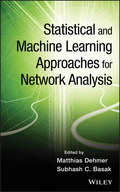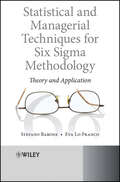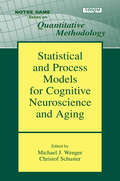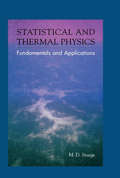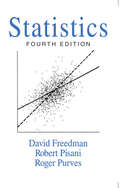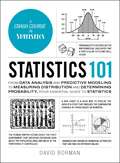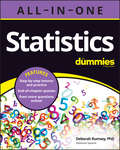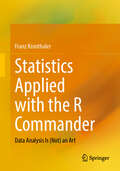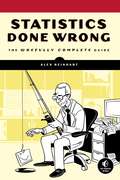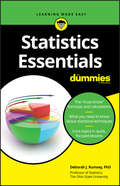- Table View
- List View
Statistical and Inductive Probabilities (Dover Books on Mathematics)
by Hugues LeblancAmong probability theorists, a bitter controversy has raged for decades between the adherents of John Maynard Keynes' A Treatise on Probability (1921) and those of Richard von Mises' "Grundlagen der Wahrscheinlichkeitsrechnung" (1919). Keynes declared that probabilities measure the extent to which a so-called evidence proposition supports another sentence. Von Mises insisted that they measure the relative frequency with which the members of a so-called reference set belong to another set. Statistical and Inductive Probabilities offers an evenhanded treatment of this issue, asserting that both statistical and inductive probabilities may be treated as sentence-theoretic measurements, and that the latter qualify as estimates of the former.Beginning with a survey of the essentials of sentence theory and of set theory, author Hugues Leblanc examines statistical probabilities (which are allotted to sets by von Mises' followers), showing that statistical probabilities may be passed on to sentences, and thereby qualify as truth-values. Leblanc concludes with an exploration of inductive probabilities (which Keynes' followers allot to sentences), demonstrating their reinterpretation as estimates of truth-values.Each chapter is preceded by a summary of its contents. Illustrations accompany most definitions and theorems, and footnotes elucidate technicalities and bibliographical references.
Statistical and Machine Learning Approaches for Network Analysis
by Matthias Dehmer Subhash C. BasakExplore the multidisciplinary nature of complex networks through machine learning techniquesStatistical and Machine Learning Approaches for Network Analysis provides an accessible framework for structurally analyzing graphs by bringing together known and novel approaches on graph classes and graph measures for classification. By providing different approaches based on experimental data, the book uniquely sets itself apart from the current literature by exploring the application of machine learning techniques to various types of complex networks.Comprised of chapters written by internationally renowned researchers in the field of interdisciplinary network theory, the book presents current and classical methods to analyze networks statistically. Methods from machine learning, data mining, and information theory are strongly emphasized throughout. Real data sets are used to showcase the discussed methods and topics, which include:A survey of computational approaches to reconstruct and partition biological networksAn introduction to complex networks--measures, statistical properties, and modelsModeling for evolving biological networksThe structure of an evolving random bipartite graphDensity-based enumeration in structured dataHyponym extraction employing a weighted graph kernelStatistical and Machine Learning Approaches for Network Analysis is an excellent supplemental text for graduate-level, cross-disciplinary courses in applied discrete mathematics, bioinformatics, pattern recognition, and computer science. The book is also a valuable reference for researchers and practitioners in the fields of applied discrete mathematics, machine learning, data mining, and biostatistics.
Statistical and Machine-Learning Data Mining: Techniques for Better Predictive Modeling and Analysis of Big Data, Third Edition
by Bruce RatnerInterest in predictive analytics of big data has grown exponentially in the four years since the publication of Statistical and Machine-Learning Data Mining: Techniques for Better Predictive Modeling and Analysis of Big Data, Second Edition. In the third edition of this bestseller, the author has completely revised, reorganized, and repositioned the original chapters and produced 13 new chapters of creative and useful machine-learning data mining techniques. In sum, the 43 chapters of simple yet insightful quantitative techniques make this book unique in the field of data mining literature. What is new in the Third Edition: The current chapters have been completely rewritten. The core content has been extended with strategies and methods for problems drawn from the top predictive analytics conference and statistical modeling workshops. Adds thirteen new chapters including coverage of data science and its rise, market share estimation, share of wallet modeling without survey data, latent market segmentation, statistical regression modeling that deals with incomplete data, decile analysis assessment in terms of the predictive power of the data, and a user-friendly version of text mining, not requiring an advanced background in natural language processing (NLP). Includes SAS subroutines which can be easily converted to other languages. As in the previous edition, this book offers detailed background, discussion, and illustration of specific methods for solving the most commonly experienced problems in predictive modeling and analysis of big data. The author addresses each methodology and assigns its application to a specific type of problem. To better ground readers, the book provides an in-depth discussion of the basic methodologies of predictive modeling and analysis. While this type of overview has been attempted before, this approach offers a truly nitty-gritty, step-by-step method that both tyros and experts in the field can enjoy playing with.
Statistical and Managerial Techniques for Six Sigma Methodology: Theory and Application
by Stefano Barone Eva Lo FrancoSix Sigma methodology is a business management strategy which seeks to improve the quality of process output by identifying and removing the causes of errors and minimizing variability in manufacturing and business processes. This book examines the Six Sigma methodology through illustrating the most widespread tools and techniques involved in Six Sigma application. Both managerial and statistical aspects are analysed allowing the reader to apply these tools in the field. Furthermore, the book offers insight on variation and risk management and focuses on the structure and organizational aspects of Six Sigma projects.Key features:* Presents both statistical and managerial aspects of Six Sigma, covering both basic and more advanced statistical techniques.* Provides clear examples and case studies to illustrate the concepts and methodologies used in Six Sigma.* Written by experienced authors in the field.This textbook is ideal for graduates studying Six Sigma for Black Belt and Green Belt qualifications as well as for engineering and quality management courses. Business consultants and consultancy firms implementing Six Sigma will also benefit from this book.
Statistical and Methodological Myths and Urban Legends: Doctrine, Verity and Fable in Organizational and Social Sciences
by Charles E. LanceThis book provides an up-to-date review of commonly undertaken methodological and statistical practices that are sustained, in part, upon sound rationale and justification and, in part, upon unfounded lore. Some examples of these "methodological urban legends", as we refer to them in this book, are characterized by manuscript critiques such as: (a) "your self-report measures suffer from common method bias"; (b) "your item-to-subject ratios are too low"; (c) "you can’t generalize these findings to the real world"; or (d) "your effect sizes are too low". Historically, there is a kernel of truth to most of these legends, but in many cases that truth has been long forgotten, ignored or embellished beyond recognition. This book examines several such legends. Each chapter is organized to address: (a) what the legend is that "we (almost) all know to be true"; (b) what the "kernel of truth" is to each legend; (c) what the myths are that have developed around this kernel of truth; and (d) what the state of the practice should be. This book meets an important need for the accumulation and integration of these methodological and statistical practices.
Statistical and Nonlinear Physics (Encyclopedia of Complexity and Systems Science Series)
by Bulbul ChakrabortyThis volume of the Encyclopedia of Complexity and Systems Science, Second Edition, focuses on current challenges in the field from materials and mechanics to applications of statistical and nonlinear physics in the life sciences. Challenges today are mostly in the realm of non-equilibrium systems, although certain equilibrium systems also present serious hurdles. Where possible, pairwise articles focus on a single topic, one from a theoretical perspective and the other from an experimental one, providing valuable insights. In other cases, theorists and experimentalists have collaborated on a single article. Coverage includes both quantum and classical systems, and emphasizes 1) mature fields that are not covered in the current specialist literature, (2) topics that fall through the cracks in disciplinary journals/books, or (3) developing areas where the knowledge base is large and robust and upon which future developments will depend. The result is an invaluable resource for condensed matter physicists, material scientists, engineers and life scientists.
Statistical and Probabilistic Methods in Actuarial Science (Chapman & Hall/CRC Series in Actuarial Science)
by Philip J. BolandStatistical and Probabilistic Methods in Actuarial Science covers many of the diverse methods in applied probability and statistics for students aspiring to careers in insurance, actuarial science, and finance. The book builds on students' existing knowledge of probability and statistics by establishing a solid and thorough understanding of
Statistical and Process Models for Cognitive Neuroscience and Aging (Notre Dame Series On Quantitative Methodology Ser.)
by Michael J. Wenger Christof SchusterStatistical and Process Models for Cognitive Neuroscience and Aging addresses methodological techniques for researching cognitive impairment, Alzheimer's disease, the biophysics and structure of the nervous system, the physiology of memory, and the analysis of EEG data. Each chapter, written by the expert in the area, provides a carefully crafted i
Statistical and Thermal Physics: An Introduction
by Michael J.R. HochThermal and statistical physics has established the principles and procedures needed to understand and explain the properties of systems consisting of macroscopically large numbers of particles. By developing microscopic statistical physics and macroscopic classical thermodynamic descriptions in tandem, Statistical and Thermal Physics: An Introduction provides insight into basic concepts and relationships at an advanced undergraduate level. This second edition is updated throughout, providing a highly detailed, profoundly thorough, and comprehensive introduction to the subject and features exercises within the text as well as end-of-chapter problems. Part I of this book consists of nine chapters, the first three of which deal with the basics of equilibrium thermodynamics, including the fundamental relation. The following three chapters introduce microstates and lead to the Boltzmann definition of the entropy using the microcanonical ensemble approach. In developing the subject, the ideal gas and the ideal spin system are introduced as models for discussion. The laws of thermodynamics are compactly stated. The final three chapters in Part I introduce the thermodynamic potentials and the Maxwell relations. Applications of thermodynamics to gases, condensed matter, and phase transitions and critical phenomena are dealt with in detail. Initial chapters in Part II present the elements of probability theory and establish the thermodynamic equivalence of the three statistical ensembles that are used in determining probabilities. The canonical and the grand canonical distributions are obtained and discussed. Chapters 12-15 are concerned with quantum distributions. By making use of the grand canonical distribution, the Fermi–Dirac and Bose–Einstein quantum distribution functions are derived and then used to explain the properties of ideal Fermi and Bose gases. The Planck distribution is introduced and applied to photons in radiation and to phonons on solids. The last five chapters cover a variety of topics: the ideal gas revisited, nonideal systems, the density matrix, reactions, and irreversible thermodynamics. A flowchart is provided to assist instructors on planning a course. Key Features: Fully updated throughout, with new content on exciting topics, including black hole thermodynamics, Heisenberg antiferromagnetic chains, entropy and information theory, renewable and nonrenewable energy sources, and the mean field theory of antiferromagnetic systems Additional problem exercises with solutions provide further learning opportunities Suitable for advanced undergraduate students in physics or applied physics. Michael J.R. Hoch spent many years as a visiting scientist at the National High Magnetic Field Laboratory at Florida State University, USA. Prior to this, he was a professor of physics and the director of the Condensed Matter Physics Research Unit at the University of the Witwatersrand, Johannesburg, where he is currently professor emeritus in the School of Physics.
Statistical and Thermal Physics: Fundamentals and Applications
by M.D. SturgeThis book is based on many years of teaching statistical and thermal physics. It assumes no previous knowledge of thermodynamics, kinetic theory, or probability---the only prerequisites are an elementary knowledge of classical and modern physics, and of multivariable calculus. The first half of the book introduces the subject inductively but rigorously, proceeding from the concrete and specific to the abstract and general. In clear physical language the book explains the key concepts, such as temperature, heat, entropy, free energy, chemical potential, and distributions, both classical and quantum. The second half of the book applies these concepts to a wide variety of phenomena, including perfect gases, heat engines, and transport processes. Each chapter contains fully worked examples and real-world problems drawn from physics, astronomy, biology, chemistry, electronics, and mechanical engineering.
Statistical models
by A. C. DavisonModels and likelihood are the backbone of modern statistics. This book gives an integrated development of these topics that blends theory and practice, intended for advanced undergraduate and graduate students, researchers and practitioners. Its breadth is unrivaled, with sections on survival analysis, missing data, Markov chains, Markov random fields, point processes, graphical models, simulation and Markov chain Monte Carlo, estimating functions, asymptotic approximations, local likelihood and spline regressions as well as on more standard topics such as likelihood and linear and generalized linear models. Each chapter contains a wide range of problems and exercises. Practicals in the S language designed to build computing and data analysis skills, and a library of data sets to accompany the book, are available over the Web.
Statistical: Ten Easy Ways to Avoid Being Misled By Numbers
by Anthony Reuben'Refreshingly clear and engaging' Tim Harford'Delightful . . . full of unique insights' Prof Sir David SpiegelhalterThere's no getting away from statistics. We encounter them every day. We are all users of statistics whether we like it or not.Do missed appointments really cost the NHS £1bn per year?What's the difference between the mean gender pay gap and the median gender pay gap?How can we work out if a claim that we use 42 billion single-use plastic straws per year in the UK is accurate?What did the Vote Leave campaign's £350m bus really mean?How can we tell if the headline 'Public pensions cost you £4,000 a year' is correct?Does snow really cost the UK economy £1bn per day?But how do we distinguish statistical fact from fiction? What can we do to decide whether a number, claim or news story is accurate? Without an understanding of data, we cannot truly understand what is going on in the world around us.Written by Anthony Reuben, the BBC's first head of statistics, Statistical is an accessible and empowering guide to challenging the numbers all around us.
Statistically Speaking: A Dictionary of Quotations
by C.C. GaitherStatistically Speaking is a book of quotations. It brings together the best expressed thoughts that are especially illuminating and pertinent to the disciplines of probability and statistics. The book is an aid for the individual who loves to quote – and to quote correctly.
Statistics
by John Hayes Mary Rack David Griswold Jay Hooper Pamela Lindemer Scott CoynerNIMAC-sourced textbook
Statistics
by Robert A. Donnelly Fatma Abdel-RaoufStatistics is a class that is required in many college majors, and it's an increasingly popular Advanced Placement (AP) high school course. In addition to math and technical students, many business and liberal arts students are required to take it as a fundamental component of their majors. A knowledge of statistical interpretation is vital for many careers. Idiot's Guides(R) Statistics explains the fundamental tenets in language anyone can understand.
Statistics (Fourth Edition)
by David Friedman Robert Pisani Roger PurvesWe are going to tell you about some interesting problems which have been studied with the help of statistical methods, and show you how to use these methods yourself. We will try to explain why the methods work, and what to watch out for when others use them. Mathematical notation only seems to confuse things for many people, so this book relies on words, charts, and tables; there are hardly any x's or y's. As a matter of fact, even when professional mathematicians read technical books, their eyes tend to skip over the equations. What they really want is a sympathetic friend who will explain the ideas and draw the pictures behind the equations. We will try to be that friend, for those who read our book.
Statistics 101: From Data Analysis and Predictive Modeling to Measuring Distribution and Determining Probability, Your Essential Guide to Statistics (Adams 101)
by David BormanA comprehensive guide to statistics—with information on collecting, measuring, analyzing, and presenting statistical data—continuing the popular 101 series. Data is everywhere. In the age of the internet and social media, we’re responsible for consuming, evaluating, and analyzing data on a daily basis. From understanding the percentage probability that it will rain later today, to evaluating your risk of a health problem, or the fluctuations in the stock market, statistics impact our lives in a variety of ways, and are vital to a variety of careers and fields of practice. Unfortunately, most statistics text books just make us want to take a snooze, but with Statistics 101, you’ll learn the basics of statistics in a way that is both easy-to-understand and apply. From learning the theory of probability and different kinds of distribution concepts, to identifying data patterns and graphing and presenting precise findings, this essential guide can help turn statistical math from scary and complicated, to easy and fun. Whether you are a student looking to supplement your learning, a worker hoping to better understand how statistics works for your job, or a lifelong learner looking to improve your grasp of the world, Statistics 101 has you covered.
Statistics All-in-One For Dummies
by Deborah J. RumseyThe odds-on best way to master stats. Statistics All-in-One For Dummies is packed with lessons, examples, and practice problems to help you slay your stats course. Develop confidence and understanding in statistics with easy-to-understand (even fun) explanations of key concepts. Plus, you’ll get access to online chapter quizzes and other resources that will turn you into a stats master. This book teaches you how to interpret graphs, determine probability, critique data, and so much more. Written by an expert author and serious statistics nerd, Statistics AIO For Dummies explains everything in terms anyone can understand. Get a grasp of basic statistics concepts required in every statistics course Clear up the process of interpreting graphs, understanding polls, and analyzing data Master correlation, regression, and other data analysis tools Score higher on stats tests and get a better grade in your high school or college classStatistics All-in-One For Dummies follows the curriculum of intro college statistics courses (including AP Stats!) so you can learn everything you need to know to get the grade you need—the Dummies way.
Statistics Applied With Excel: Data Analysis Is (Not) an Art
by Franz KronthalerThis book shows you how to analyze data sets systematically and to use Excel 2019 to extract information from data almost effortlessly. Both are (not) an art!The statistical methods are presented and discussed using a single data set. This makes it clear how the methods build on each other and gradually more and more information can be extracted from the data. The Excel functions used are explained in detail - the procedure can be easily transferred to other data sets. Various didactic elements facilitate orientation and working with the book: At the checkpoints, the most important aspects from each chapter are briefly summarized. In the freak knowledge section, more advanced aspects are addressed to whet the appetite for more. All examples are calculated with hand and Excel. Numerous applications and solutions as well as further data sets are available on the author's internet platform. This book is a translation of the original German 2nd edition Statistik angewandt mit Excel by Franz Kronthaler, published by Springer-Verlag GmbH Germany, part of Springer Nature in 2021. The translation was done with the help of artificial intelligence (machine translation by the service DeepL.com). A subsequent human revision was done primarily in terms of content, so that the book will read stylistically differently from a conventional translation. Springer Nature works continuously to further the development of tools for the production of books and on the related technologies to support the authors.
Statistics Applied to Clinical Studies
by Aeilko H. Zwinderman Ton J. CleophasThanks to the omnipresent computer, current statistics can include data files of many thousands of values, and can perform any exploratory analysis in less than seconds. This development, however fascinating, generally does not lead to simple results. We should not forget that clinical studies are, mostly, for confirming prior hypotheses based on sound arguments, and the simplest tests provide the best power and are adequate for such studies. In the past few years the authors of this 5th edition, as teachers and research supervisors in academic and top-clinical facilities, have been able to closely observe the latest developments in the field of clinical data analysis, and they have been able to assess their performance. In this 5th edition the 47 chapters of the previous edition have been maintained and upgraded according to the current state of the art, and 20 novel chapters have been added after strict selection of the most valuable and promising novel methods. The novel methods are explained using practical examples and step-by-step analyses readily accessible for non-mathematicians. All of the novel chapters have been internationally published by the authors in peer-reviewed journal, including the American Journal of Therapeutics, the European Journal of Clinical Investigation, The International journal of Clinical Pharmacology and therapeutics, and other journals, and permission is granted by all of them to use this material in the current book. We should add that the authors are well-qualified in their fields of knowledge. Professor Zwinderman is president-elect of the International Society of Biostatistics, and Professor Cleophas is past-president of the American College of Angiology. From their expertise they should be able to make adequate selections of modern methods for clinical data analysis for the benefit of physicians, students, and investigators. The authors, although from a different discipline, one clinician and one statistician, have been working and publishing together for over 10 years, and their research of statistical methodology can be characterized as a continued effort to demonstrate that statistics is not mathematics but rather a discipline at the interface of biology and mathematics. They firmly believe that any reader can benefit from this clinical approach to statistical data analysis.
Statistics Applied with the R Commander: Data Analysis Is (Not) an Art
by Franz KronthalerThis book shows you how to analyze data sets systematically and to use the R Commander to extract information from data almost effortlessly. Both are (not) an art! The statistical methods are presented and discussed using a single data set. This makes it clear how the methods build on each other and gradually more and more information can be extracted from the data. R and the R Commander functions used are explained in detail – the procedure can be easily transferred to other data sets. The book thus provides a simple introduction to professional and free statistical software. Various didactic elements facilitate orientation and working with the book: At the checkpoints, the most important aspects from each chapter are briefly summarized. In the freak knowledge section, more advanced aspects are addressed to whet the appetite for more. All examples are calculated with hand and the R Commander. Numerous applications and solutions as well as further data sets are available on the author's internet platform. This book is a translation of the original German 2nd edition Statistik angewandt mit dem R Commander by Franz Kronthaler, published by Springer-Verlag GmbH Germany, part of Springer Nature in 2021. The translation was done with the help of artificial intelligence (machine translation by the service DeepL.com). A subsequent human revision was done primarily in terms of content, so that the book will read stylistically differently from a conventional translation. Springer Nature works continuously to further the development of tools for the production of books and on the related technologies to support the authors.
Statistics Based on Dirichlet Processes and Related Topics (SpringerBriefs in Statistics)
by Hajime YamatoThis book focuses on the properties associated with the Dirichlet process, describing its use a priori for nonparametric inference and the Bayes estimate to obtain limits for the estimable parameter. It presents the limits and the well-known U- and V-statistics as a convex combination of U-statistics, and by investigating this convex combination, it demonstrates these three statistics. Next, the book notes that the Dirichlet process gives the discrete distribution with probability one, even if the parameter of the process is continuous. Therefore, there are duplications among the sample from the distribution, which are discussed. Because sampling from the Dirichlet process is described sequentially, it can be described equivalently by the Chinese restaurant process. Using this process, the Donnelly–Tavaré–Griffiths formulas I and II are obtained, both of which give the Ewens’ sampling formula. The book then shows the convergence and approximation of the distribution for its number of distinct components. Lastly, it explains the interesting properties of the Griffiths–Engen–McCloskey distribution, which is related to the Dirichlet process and the Ewens’ sampling formula.
Statistics Crash Course for Beginners: Theory and applications of Frequentist and Bayesian statistics using Python
by AI Sciences OUA beginner-friendly crash course to statistics utilizing Python with an eye to preparing students for further study in machine learningKey FeaturesA quick introduction to Python for statisticsHands-on projects for guided practiceInstant access to PDFs, Python codes, exercises, and references on the publisher's website at no extra costBook DescriptionData and statistics are the core subjects of Machine Learning (ML). The reality is that the average programmer may be tempted to view statistics with disinterest. But if you want to exploit the incredible power of ML, you need a thorough understanding of statistics. The reason is that a machine learning professional develops intelligent and fast algorithms that learn from data. This Statistics Crash Course for Beginners presents you with an easy way of learning statistics fast.Contrary to popular belief, statistics is no longer the exclusive domain of math PhDs. It's true that statistics deals with numbers and percentages. Hence, the subject can be very dry and boring. This book, however, transforms statistics into a fun subject.Frequentist and Bayesian statistics are two statistical techniques that interpret the concept of probability in different ways. Bayesian statistics was first introduced by Thomas Bayes in the 1770s. Bayesian statistics has been instrumental in the design of high-end algorithms that make accurate predictions. So, even after 250 years, the interest in Bayesian statistics has not faded. In fact, it has accelerated tremendously.Frequentist statistics is just as important as Bayesian statistics. In the statistical universe, Frequentist statistics is the most popular inferential technique. In fact, it's the first school of thought you come across when you enter the statistics world.By the end of this course, you will have built a solid foundation in statistical theory and practice that will prepare you for further study in machine learning and a career in programming. The code bundle for this course is available at https://www.aispublishing.net/nlp-crash-course1605125706681What you will learnGet a crash course in Python for statisticsUtilize Python to determine probability, random variables, and probability distributionsStudy descriptive statistics, measuring central tendency and spreadPerform exploratory analysis, such as data visualizationPractice statistical inference, frequentist inference, and Bayesian inferenceSuccessfully complete several real-world projectsWho this book is forThis course is intended for anyone interested in learning Frequentist and Bayesian statistics, either as a first step to machine learning or basic programming. No prior experience is required.
Statistics Done Wrong
by Alex ReinhartScientific progress depends on good research, and good research needs good statistics. But statistical analysis is tricky to get right, even for the best and brightest of us. You'd be surprised how many scientists are doing it wrong.Statistics Done Wrong is a pithy, essential guide to statistical blunders in modern science that will show you how to keep your research blunder-free. You'll examine embarrassing errors and omissions in recent research, learn about the misconceptions and scientific politics that allow these mistakes to happen, and begin your quest to reform the way you and your peers do statistics.You'll find advice on:–Asking the right question, designing the right experiment, choosing the right statistical analysis, and sticking to the plan–How to think about p values, significance, insignificance, confidence intervals, and regression–Choosing the right sample size and avoiding false positives–Reporting your analysis and publishing your data and source code–Procedures to follow, precautions to take, and analytical software that can helpScientists: Read this concise, powerful guide to help you produce statistically sound research. Statisticians: Give this book to everyone you know.The first step toward statistics done right is Statistics Done Wrong.
Statistics Essentials For Dummies
by Deborah J. RumseyStatistics Essentials For Dummies (9781119590309) was previously published as Statistics Essentials For Dummies (9780470618394). While this version features a new Dummies cover and design, the content is the same as the prior release and should not be considered a new or updated product. Statistics Essentials For Dummies not only provides students enrolled in Statistics I with an excellent high-level overview of key concepts, but it also serves as a reference or refresher for students in upper-level statistics courses. Free of review and ramp-up material, Statistics Essentials For Dummies sticks to the point, with content focused on key course topics only. It provides discrete explanations of essential concepts taught in a typical first semester college-level statistics course, from odds and error margins to confidence intervals and conclusions. This guide is also a perfect reference for parents who need to review critical statistics concepts as they help high school students with homework assignments, as well as for adult learners headed back into the classroom who just need a refresher of the core concepts. The Essentials For Dummies SeriesDummies is proud to present our new series, The Essentials For Dummies. Now students who are prepping for exams, preparing to study new material, or who just need a refresher can have a concise, easy-to-understand review guide that covers an entire course by concentrating solely on the most important concepts. From algebra and chemistry to grammar and Spanish, our expert authors focus on the skills students most need to succeed in a subject.

